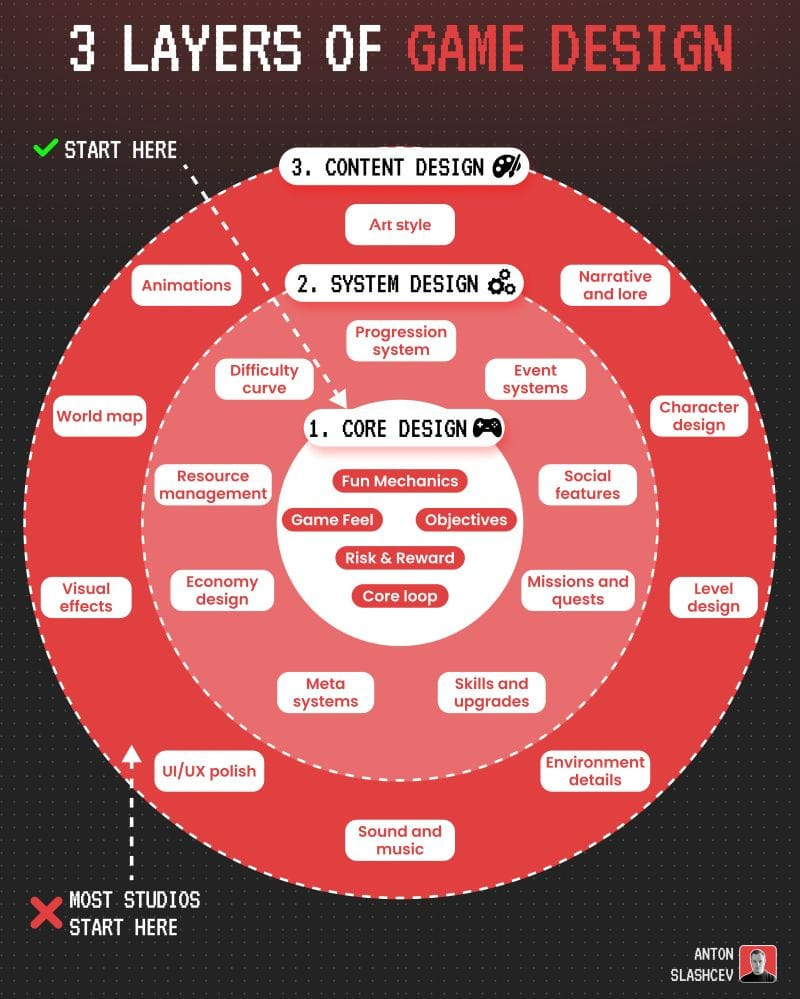The 3 layers of game design
Some time ago, I proposed a way to categorize my game ideas. The goal was to find a way to prioritize ideas based on the idea's complexity. From 2D games (defined as I, II, III) to 3D games (A, AA, AAA), a smaller scope makes the game more doable.
But then, thanks to Weiqing Teh's newsletter (it's a minimalist newsletter with lots of goodness—subscribe!), I learned of an additional way.
Meet the 3 layers of game design:
Pure essence of knowledge (and you could write a year of newsletters based on that... now why would I spoil that for you? 😉).
At first, I thought that this my replace my system, but now I see it will complement it. The three layers of game design show the ingredients of (almost) every game and can be used to structure a game idea. I will just have to go through every idea and assign a value to it. 😉
But how can it help me compose ideas better?
First, it tells me which ideas are to be implemented first. Some ideas are closer to being core design section. These will be the first pick. Then, by looking at the structure, I will know what other design elements are missing. Which will lead me to search what other ideas I need. When they're already done? Even better. Less work ;-)
But what if I have a few ideas for core designs?
That's not a bad thing. Implement them, and then add system and content designs to them iteratively. If, like me, you want to make RPGs, then you can make a template of core designs and reuse it.
I don't have core design ideas, only system and content...
Well, you know what's missing then. Maybe think of core design ideas that could help? What games with similar systems and content ideas to yours look like? What are their core design ideas? Or, look at your ideas and think about what core design ideas would complement them.
So, how many ways of prioritizing ideas are you using right now?
Let me check...
The minimum environment to implement it (2D/3D)
How much I want to do it (MoSCoW)
The already mentioned game complexity way
Type of idea (Sensory, Story, Setting, Mechanic, Character, Artifact) - I consider mechanic to be high priority, and the rest to be less priority
And now, the three layers of game design
Of course, the "minimum environment to implement it" is now redundant due to the game's complexity (which also contains environment info).
But I believe the rest will complement themselves.
I'm trying to master Obsidian now. I've been using it for years, but only recently have I learned something about how to really use it.
It might lead me to a way to organize ideas into blueprints (more on that perhaps in another issue, once the method is crystalized). Recently, I tried to create a system for this in Notion, but the truth is - it's a pretty good storage tool, but retrieving information in a creative way might prove to be challenging. Not to mention that my recent adventures with AirTable (link) led me to believe that their patience towards my usage of their API might end sooner than I think. After all, keeping all that info takes storage that someone has to pay for. While Obsidian can be stored on a local hard drive. Or Dropbox (yes, you have to pay for Dropbox at some point, but they at least mention memory usage, so it's clear when you're using too much of their hospitability).
So yes, right now, I try to make a solid structure for notes in Obsidian. Once that I will see how much it would be better to keep in Obsidian and not SaaSsy databases.



Obsidian is my favorite note-taking app! The more you use it, the more you realize how powerful and flexible it is. The Canvas feature is great for brainstorming.
This is a great breakdown for development. I love the chart!